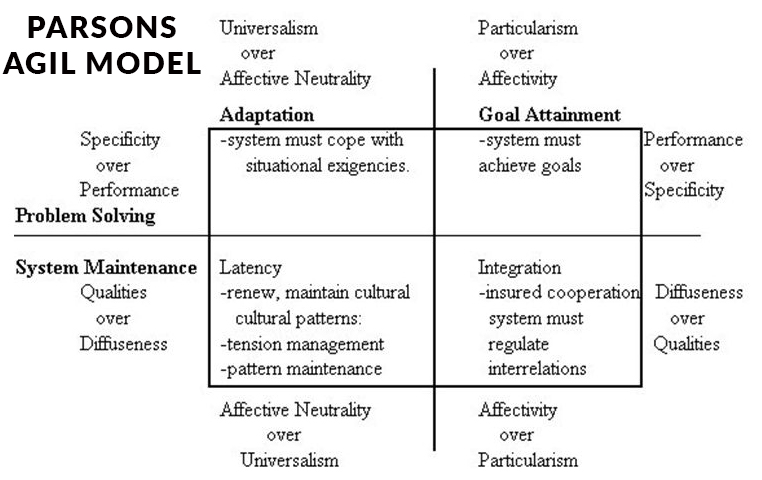- Home
- Prelims
- Mains
- Current Affairs
- Study Materials
- Test Series
 EDITORIALS & ARTICLES
EDITORIALS & ARTICLES
Describe the functional prerequisites of social system as given by Talcott Parsons. Examine in the context of a university as a social system. (UPSC CSE Mains 2016 - Sociology, Paper 1)
Talcott Parsons, a structural functionalist, said all systems, whether it be the family, the economy, or the polity, establish boundaries to sustain themselves. This self-maintenance is made possible by the socialization of individuals in society, which shapes their motivational and value orientations. To ensure their survival, social systems must establish crucial adjustments between their internal organization and the external environment.
Parsons argues that social systems possess inherent mechanisms for self-adjustment and self-preservation. These adjustment processes, which uphold the internal functioning of the system and its relationship with the surrounding conditions, are referred to as functions. Functions represent the system’s means of self-maintenance.
Talcott Parsons identified specific functions that are essential for the survival of a social system. He referred to these functions as “functional prerequisites.”
- Adaptation,
- Goal attainment,
- Integration
- Latency

- Parsons developed a model of system exchanges that consists of four functional prerequisites. These prerequisites are crucial for the functioning of a social system and can be categorized based on their relationship to the system’s internal or external processes. They can also be classified as either consummatory or instrumental in nature.
- The first functional prerequisite is adaptation, which involves acquiring and utilizing resources from the external environment to sustain the system. For instance, the economic system relies on resource utilization, production, and distribution within society. Adaptation is instrumental in nature and focuses on factors external to the system. In the context of University as a social system, adaptation involves acquiring resources in the form of infrastructure etc.
- The second prerequisite is goal attainment, which entails setting goals, motivating system members to achieve those goals, and mobilizing their efforts. Goal attainment is consummatory in character, although it involves some external interaction. Political processes and the organization of power and authority exemplify this prerequisite. In the context of University as a social system, goal attainment is taken up by the adminsitrative board and the syndicate members taking a note of external happenings outside the university.
- Integration is the third functional prerequisite, responsible for maintaining coherence, solidarity, and coordination within the system. Culture and values play a significant role in performing this function. Integration ensures system continuity, coordination, and solidarity, protecting it from breakdown or disruption. Integration is internal to the system and has a consummatory nature. In the context of University as a social system, integration is done by the unique culture and values of the university. For example Gandhigram Rural Institute, Dindigul, Tamilnadu is ahped up by the adherence to Gandhian values.
- The fourth prerequisite is latency, which involves storing, organizing, and maintaining the motivational energy of system elements. It focuses on pattern maintenance and tension management within the system. The socialization process of system members fulfills this function. Latency is essential for maintaining stability and managing tensions within the system. In the context of University as a social system, latency is done by the interactive means like students union in a deliberative democratic way.
- In a complex system, different parts may specialize in specific functional phases, with each part prioritizing certain activities on behalf of the entire system. Parsons emphasized that the concept of a system depends on the purpose of analysis, whether it considers the system as a whole or its subsystems and sub-subsystems. Furthermore, sub-systems may engage in multiple functions to meet their own specific requirements.
- Parsons later explored the interchanges between functionally differentiated phases within the system. He recognized the need for balanced exchanges between the adaptive phase and the goal attainment phase, as resources from the adaptive phase must be transferred to support the activities of goal attainment. Similarly, the government fulfills the goal-attainment function for society, and in return, the adaptive system must provide resources to sustain the government.
- Overall, Parsons’s model of system exchanges provides insights into the functioning and interdependencies of social systems, highlighting the importance of maintaining balanced relationships between their various functional prerequisites.
- Parsons’s framework offers a nuanced understanding of system dynamics, allowing for intricate analyses. It can be further developed by examining the patterns of interaction and exchange between the different phases, such as the interface between the I (Integration) and L (Latency) phases, which also require certain resources. Additionally, exploring the nested nature of these exchange patterns reveals the hierarchy of sub-systems and their relationships with the encompassing system, along with their own internal exchanges.
- The application of the AGIL model extends from interpersonal interactions to societal levels, encompassing various complexities. Elaborating on these patterns requires a sophisticated and multifaceted approach.
- Supplementing this model are four action systems, each serving a functional imperative: the behavioral organism fulfills the adaptive function, the personality system serves goal attainment, the social system performs integration, and the cultural system maintains patterns. Parsons observed these action systems operating at different levels of analysis, starting from the behavioral organism and progressing to the cultural system. He viewed these levels as hierarchical, with each level being influenced by and controlling the levels below it.
- Parsons primarily focused on the establishment of social order, basing his theory on several assumptions. He recognized the interdependence of systems, their tendency toward equilibrium, the potential for static or changing states, the significance of allocation and integration at equilibrium points, and the self-maintaining nature of systems. These assumptions guided his emphasis on order while somewhat overlooking the aspect of change.









 Latest News
Latest News General Studies
General Studies